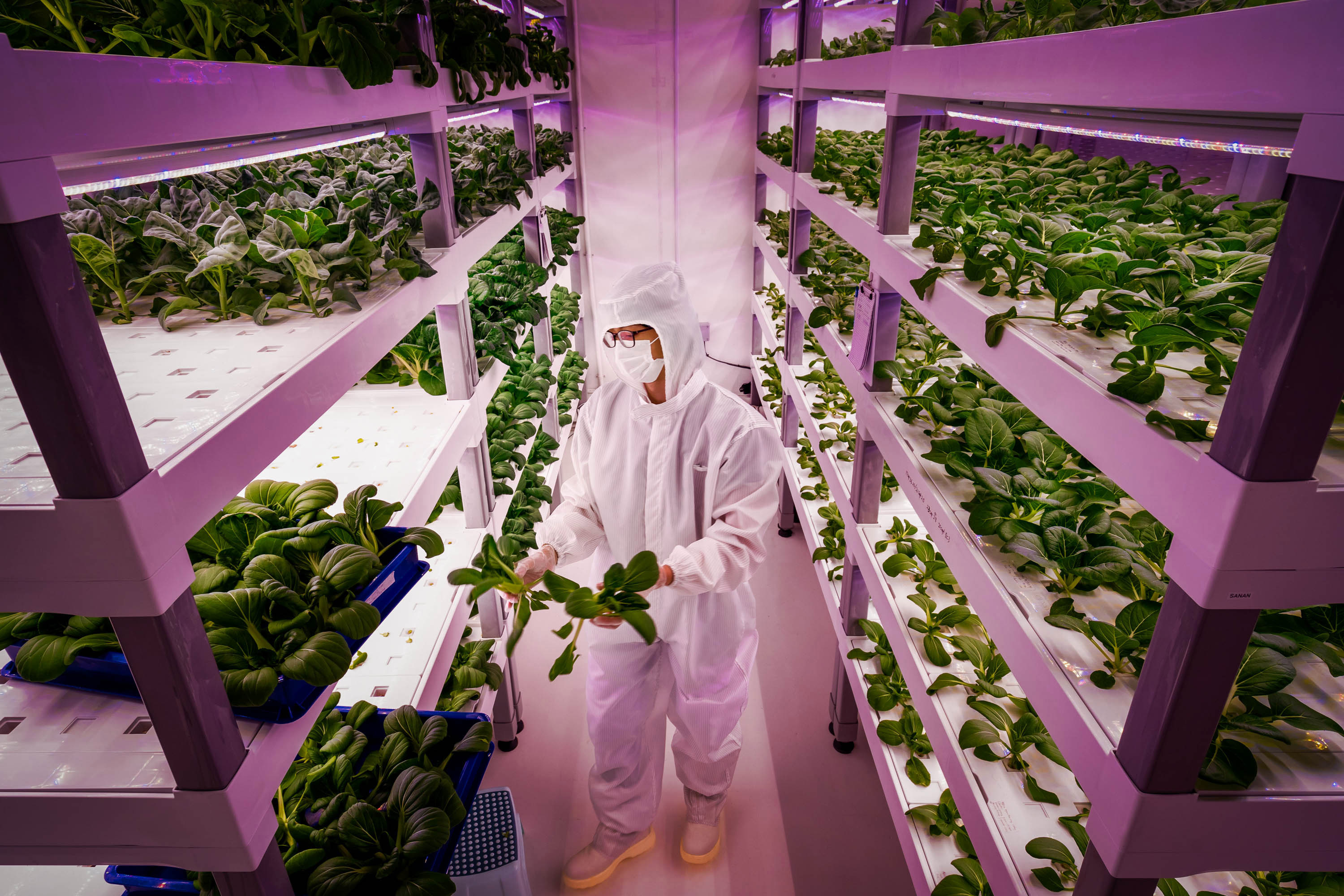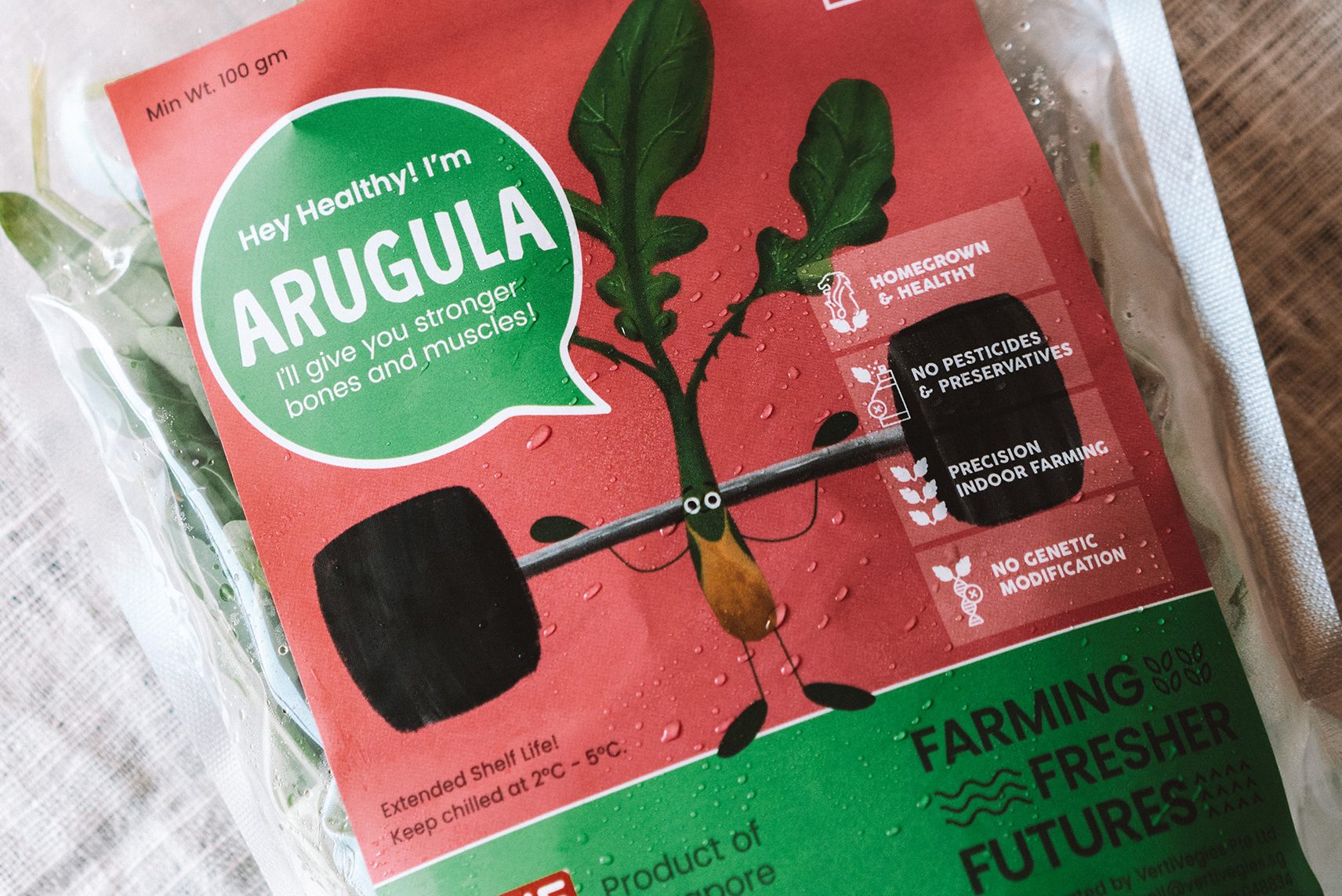From the outside, VertiVegies looked like a handful of grubby shipping containers put side by side and drilled together. A couple of meters in height, they were propped up on a patch of concrete in one of Singapore’s nondescript suburbs. But once he was inside, Ankesh Shahra saw potential. Huge potential.
Shahra, who wears his dark hair floppy and his expensive-looking shirts with their top button casually undone, had a lot of experience in the food industry. His grandfather had founded the Ruchi Group, a corporate powerhouse in India with offshoots in steel, real estate, and agriculture; his father had started Ruchi Soya, a $3 billion oilseed processor that had been Shahra’s training ground.
By the time Shahra was introduced to VertiVegies founder Veera Sekaran at a friend’s party in 2017, he was hungry to make his own entrepreneurial mark. A previous attempt had involved sourcing organic food from around Asia: “an eye-opening experience, one with a lot of pressure,” he says. It helped him spot a problem that needed solving.
“I’d seen how much dependency farmers have globally on weather,” he says. “Yields were hugely erratic: there are so many inconsistencies and dependencies that it’s a hugely difficult profession for the bulk of farmers. The perishable supply chain was so broken.”
And what Shahra saw when he stepped into Sekaran’s repurposed shipping containers was a solution.
Inside, mismatched plastic trays sat carefully stacked on industrial metal shelves, stretching all the way from the concrete floor to the corrugated-steel ceiling. In each tray were small green plants of different species and sizes, all with their roots bathed in the same watery solution, their leaves curling up toward the same pink glow of faintly humming LED bar lights above.
COURTESY OF VERTIVEGIES
With VertiVegies, Sekaran was farming vertically: growing vegetables indoors, with towers of crops stacked one on the other instead of in wide, sprawling fields, and in hydroponic solution instead of soil. He was growing food without exposure to weather or seasons, using techniques pioneered by others, in a country that was badly in need of a new way to meet its food needs.
Singapore is the third most densely populated country in the world, known for its tightly packed high-rises. But to cram all those gleaming towers and nearly 6 million people into a land mass half the size of Los Angeles, it has sacrificed many things, including food production. Farms make up no more than 1% of its total land (in the United States it’s 40%), forcing the small city-state to shell out around $10 billion each year importing 90% of its food.
Here was an example of technology that could change all that.
Sekaran came from a world very different from Shahra’s. The fifth of nine children, he had lost his father at five years old and grew up poor. So little money did the family have that Sekaran would show up to school in an oversized uniform, clutching his textbooks in a paper bag. But he climbed out of poverty, paying his own way through university and never losing his irrepressible passion for living things. By the time the pair met, Sekaran had qualified as a botanist and worked in the Seychelles, Pakistan, and Morocco before returning home. In almost every media interview or biography he is referred to, almost reverently, as a “plant whisperer.”
“We were two different personalities for sure,” says Shahra with a chuckle. But in VertiVegies, Sekaran had created the prototype for a vision both men shared.
“It was intriguing,” Shahra says. “On paper, indoor farming solves all sorts of problems. But for me it was about: How do we make a sustainable business model out of it? You’re not going to solve food security with five or 10 containers.”
He spent six months in discussion with Sekaran, and months more visiting urban-farm specialists across the region, learning every single thing he could. “All of 2017 was spent going through the systems, the technology, and just not being able to wrap my head around how to scale it,” he says.
The solution, when it came, felt surprisingly serendipitous.
Trouble at home
It’s taken decades for Singapore to wake up and realize that—as far as food goes—it is one of the most vulnerable countries in the world.
This risk simply hadn’t occurred to authorities back in the 1970s, when they ripped up the crops of tapioca, sweet potatoes, and vegetables flourishing across more than 15,000 hectares of the country’s land and replaced them with high-rise office buildings and condos. The focus back then was finance, telecoms, and electronics, not food.
But while this strategy successfully swelled Singapore’s economy (it’s now the fourth richest country in the world, per capita), it left the country with only 600 hectares of farmland. Food manufacturing is now worth just S$4.3 billion, or 1% of GDP, compared with just over 5% in the US.
The precariousness of this situation hit home in 2008, when—a few months before the global financial crisis took hold—the world suffered a spike in food prices. Bad weather, rising fuel costs, and population growth had converged to send the cost of food commodities soaring. There were riots and widespread political unrest.

ZAKARIA ZAINAL
Without production of its own, Singapore saw its food supplies take a big hit. Imported raw food rose 55% in price in 12 months, and commodities such as rice, grain, and maize as much as 31%. The state was forced to absorb hikes in the costs of basics like cooking oil, bread, and milk—something made even tougher by the fact that China, from which Singapore imports around $600 million worth of food each year, had experienced its worst winter weather in 50 years, destroying crops and further pushing up regional food prices from late 2007 to mid-2008.
Delivering the bad news to parliament in February 2008, the finance minister, Tharman Shanmugaratnam, warned that “the factors … which have led to these food price increases are not expected to go away soon.” Singapore needed to act.
The government’s policy is to produce enough food to supply 30% of its own nutritional needs by 2030, up from just 10% now.
Since then, food security has raced up the agenda. Now the government’s stated policy is that it wants to produce enough food to supply 30% of its own nutritional needs by 2030, up from just 10% now. To get there, it says, Singapore will need to grow 50% of all fruits and vegetables consumed domestically, 25% of all proteins, and 25% of all staples, such as brown rice. The commitment effectively aims to triple production by volume in the next 10 years. And since the country is short of land, it has pinned its hopes on technology. This year alone Singapore’s government has set aside S$55 million (US$40million) to fund agritech projects. Scouting teams have been bundled off on food security fact-finding missions, and sprawling agritech parks have been built.
For Shahra and Sekaran, the turning point came in August 2017, when authorities started making plots of farmland available to any company using tech or innovation to boost food security.
The 10 government-owned plots, each around two hectares in size, are all in Lim Chu Kang—a patch of green north of the city, where fruit trees, dairy farms, and organic vegetable operations provide a small supply of local produce. Startups that could convince the authorities their plan had legs would be sold the land at a fraction of its market value.
Finally, Shahra had a way to scale up VertiVegies. “It would take away our biggest hurdle,” he says of the announcement. “It would unlock the ability to expand.”
They hurriedly pulled together a proposal using all the information they’d gathered in the previous months. By February 2018 they were successful, and by June they’d taken possession of a S$300,000 plot and laid out their vision.

COURTESY OF VERTIVEGIES
Once completed, the new farm will be Singapore’s biggest: the warehouse will stretch 20,000 square meters (roughly the size of three soccer fields) and, once at full capacity, produce six metric tons of leafy greens, microgreens, and herbs each day, to supply restaurants, retailers, and hotels. Not only will the plants grow up to 25% faster than those in a conventional outdoor field if all goes to plan, but with no soil and with a farming stack up to two meters high, they will require around a fifth as much room to grow as conventional crops. If it can meet its production targets, it will singlehandedly boost Singapore’s vegetable production by 10%.
But it isn’t scale alone that separates VertiVegies from the competition. Only six months after securing the plot of land, Shahra also signed a deal with SananBio. The Chinese company is arguably the world’s biggest provider of vertical farming technology, operating vast indoor farms of its own in China, which committed in 2017 to investing $1 billion in scaling the technology. “The amount of R&D SananBio has invested in indoor farming solutions, we could never do. They were several years ahead of all the other companies I visited,” says Shahra. But thanks to the joint venture signed in August 2018, his team has access to not only SananBio’s physical growing systems, but its years of data on how to grow better and faster.
The covid-19 pandemic has put plans for the main growing operation on hold, with focus temporarily switching to a smaller alternative that will be faster to build and easier to set up: it aims to produce 700 to 800 kilograms of vegetables per day. And in doing so, it will demonstrate a future for high-tech indoor farms in which the technology can finally be used to make a meaningful contribution to mainstream production.
A global problem
Food security is a pressing issue in Singapore, but it’s a growing concern almost everywhere else too.
The world’s population is set to swell by a quarter by 2050, to 9.7 billion, creating an urgent need for more food. Estimates of exactly how much more vary from 25% to 70%, but nobody disputes that we’ll need more of everything: more grains, more meat, and far more fresh vegetables. Already the high cost of producing and distributing food is worsening global malnutrition: 690 million people were left without enough to eat in 2019, up 10 million from 2018. Failure to increase production will tip millions more into chronic hunger.
Conventional outdoor food production is unlikely to meet this demand, especially with outdoor crops already feeling the impact of climate change. In 2019 alone, weather problems exacerbated by global warming hit the food system with a string of disasters: a heat wave hit farms in the US Midwest, severe cyclones destroyed corn output in sub-Saharan Africa, India battled relentless drought, and farmers on the banks of Asia’s Mekong River watched helplessly as rising water washed away livestock.
Urbanization only makes this harder, cutting the amount of farmland available and putting more people in closer proximity to each other. The United Nations says that by 2050, 68% of the world will live in densely populated urban areas—up from 55% today. That will make them more reliant on imports and vulnerable to even small shocks to the market, or disruptions to supply.


















